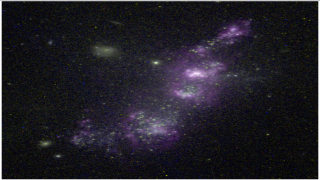Bibcode
Calvi, R.; Rodríguez Espinosa, J. M.; Mas-Hesse, J. M.; Chanchaiworawit, K.; Guzman, R.; Salvador-Solé, E.; Gallego, J.; Herrero, A.; Manrique, A.; Marín Franch, A.
Bibliographical reference
Monthly Notices of the Royal Astronomical Society
Advertised on:
11
2019
Citations
15
Refereed citations
14
Description
The epoch corresponding to a redshift of z ̃ 6.5 is close to full re-ionization of the Universe, and early enough to provide an intriguing environment to observe the early stage of large-scale structure formation. It is also an epoch that can be used to verify the abundance of a large population of low luminosity star-forming galaxies that are deemed responsible for cosmic re-ionization. Here, we present the results of follow-up multi-object spectroscopy using OSIRIS at Gran Telescopio Canarias of 16 Ly α emitter (LAE) candidates discovered in the Subaru/XMM Newton Deep Survey. We have securely confirmed 10 LAEs with sufficient signal-to-noise ratio of the Ly α emission line. The inferred star formation rates of the confirmed LAEs are on the low side, within the range 0.9-4.7 M☉ yr-1. However, they show relatively high Ly α rest frame equivalent widths. Finally we have shown that the mechanical energy released by the star formation episodes in these galaxies is enough to create holes in the neutral hydrogen medium such that Lyman continuum photons can escape to the intergalactic medium, thus contributing to the re-ionization of the Universe.
Related projects

Starbursts in Galaxies GEFE
Starsbursts play a key role in the cosmic evolution of galaxies, and thus in the star formation (SF) history of the universe, the production of metals, and the feedback coupling galaxies with the cosmic web. Extreme SF conditions prevail early on during the formation of the first stars and galaxies, therefore, the starburst phenomenon constitutes a
Casiana
Muñoz Tuñón

Physical properties and evolution of Massive Stars
This project aims at the searching, observation and analysis of massive stars in nearby galaxies to provide a solid empirical ground to understand their physical properties as a function of those key parameters that gobern their evolution (i.e. mass, spin, metallicity, mass loss, and binary interaction). Massive stars are central objects to
Sergio
Simón Díaz